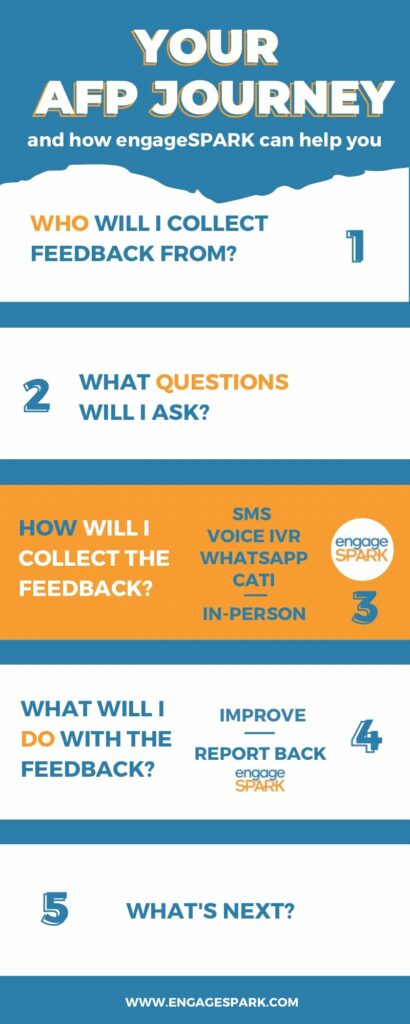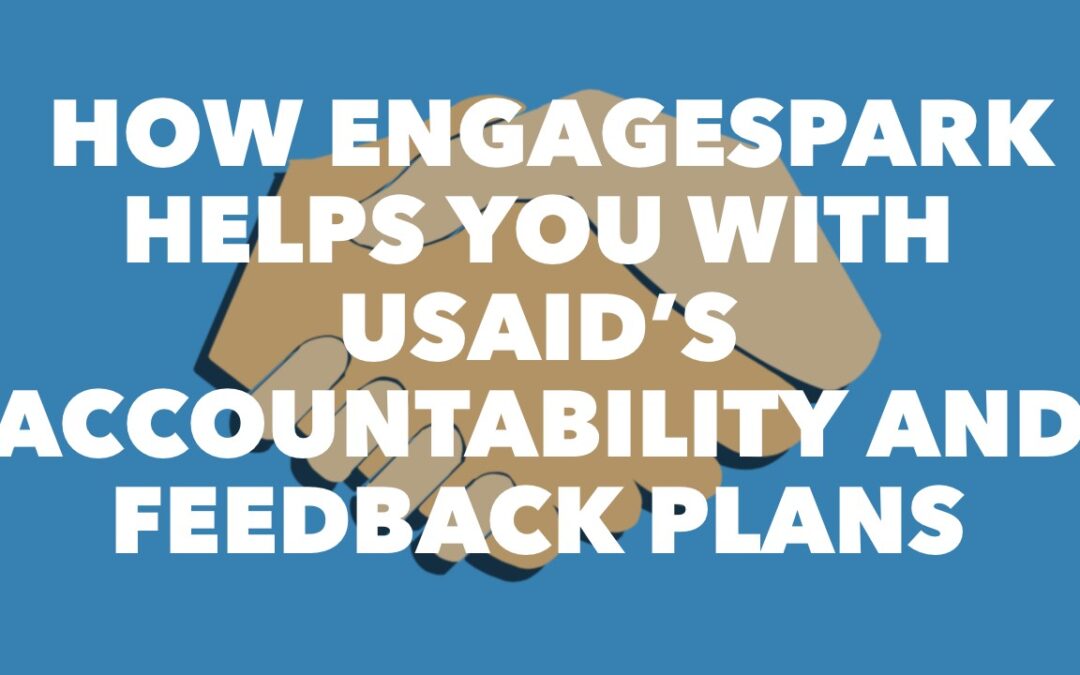How do you make sure that your intervention actually benefits the constituents you’re trying to serve? How do you make sure that it has maximum impact? These and related questions usually have one answer: M&E—Monitoring and evaluation.
Recently, USAID—that giant US government agency for international development—has added a new piece to its M&E requirements: AFPs. How are they different from previous feedback gathering efforts—and how can you collect this feedback effectively? We’ll answer these questions in this blog post.
What are Accountability and Feedback Plans (AFPs)?
If you’re going to do a project for USAID, or are someone tasked with overseeing one, then you’ll probably have to come up with a so called AFP—short for Accountability and Feedback Plan. In this document you’ll explain how you’re going to involve people in the planning and evaluation of your project.
How can you make it the most effective? How can you make sure you get feedback from a wide range of stakeholders, not just the easiest to talk to? After you have processed the feedback you received from constituents about your intervention, how will these constituents hear back from you about what changed, if anything?
Of course, you might wonder: what’s new about this? Beneficiary Feedback Plans (BFPs) have been around for a while, after all. So let’s talk about how AFPs go further than BFPs.
But aren’t there Beneficiary Feedback Plans (BFP) already?
In short: BFPs got the ball rolling on getting feedback, AFPs make sure you don’t get off the hook too easily. 😉 An “enhanced version”, as they put it, to identify and consult “key voices”. Specifically it’s about:
[…] intentionally reaching and consulting underserved and marginalized voices including, women,
youth, with particular focus on girls, LGBTQI+, indigenous and persons with disabilities.
So, it’s not good enough that community leaders and your contracting partner give you the thumbs up. You have to dig deep—and make a plan for that. With AFPs, USAID wants you to broaden whom you involve in the design of the intervention, and whom you collect feedback from.
And while this is a requirement for USAID programs going forward, it really is about making sure that your project has the best possible impact on the community you’re serving.
The five steps of the AFP journey

To set up and use an Accountability and Feedback Plan you will likely have to answer these five questions, as outlined in the USAID docs:
- Who will I collect feedback from? As mentioned, this is the critical piece of AFPs—identifying the “key voices” so that you hear from diverse people, giving you very different points of view. You can either talk to constituents whose lives your program wants to impact, or to indirect constituents, such as contractors, representatives from the wider community, etc.
- What questions will I ask? There are various things to learn, from how important they think your program is to their lives, to how it’s being done, and how inclusive it’s being done. Almost as important as the question itself is often how the question is asked and the survey is done.
For example, at engageSPARK we have seen surveys fail because participants are overwhelmed by way too many questions. Another frequent source of problems is the phrasing: it’s not clear how to answer the question correctly. How can you do better? Read here about best practices for SMS Surveys. There are many tips on our blog. - How will I collect the feedback? You can either approach constituents for this purpose, or make feedback gathering part of an existing habit, for example a meeting that’s happening anyway. Keep in mind that AFPs are encouraging the inclusion of people from marginalized groups … as the name says, these people are marginalized, and may suffer repercussions for speaking out. Your feedback mechanisms should aim to be confidential, private and secure, and generally minimize the use of personally identifiable information (PII).
- What will I do with the feedback? First it’s important to find recurring themes and validate the feedback. When you’re sufficiently sure you understand the root cause, you can devise a strategy to do better. Finally, you can and should report back—not just to USAID HQ but also, and especially, to your constituents so they know their voices have in fact been heard.
- What’s next? Ideally, an AFP isn’t set in stone, not done once and then forgotten. Instead, it’s meant to be an iterative process: each time you do it, you ask how you can improve whom you ask, the questions you ask, how you garner feedback, and how you report it and follow up on it. That way it matures, like a good wine. 🙂
So, why are we writing about all this? Well, we believe we can help you with your M&E efforts—as we have helped many others.
Where engageSPARK comes in
We at engageSPARK help organizations like yours communicate with people—often automated and at scale. So, for example, when IOM wants to survey migrants in Ghana using Voice IVR or at times illiterate migrants in Senegal using WhatsApp, we help do that. Read (many) more examples here.
The main tools we use are available through our web platform (you can sign up for free and check it out here—no credit card required):
- Voice IVR Survey: Make automated phone calls that ask questions and get answers using keypresses or voice recordings. You can either pre-record those questions or use text-to-speech to get started. One of the beauties of IVR: you can even reach illiterate people.
- SMS Survey: Ask questions, get answers—and like with IVR, all your constituents need is a simple feature phone (those pre-iPhone things 🙂 ).
- Airtime Incentives: Send pre-paid load as an incentive for survey completion, or to help participants take the survey.
- WhatsApp Survey: Ask questions with text messages … or with audio recordings, images, videos, PDF documents.
- CATI Survey: Do you want to try voice calls to gather feedback but don’t want to do automated calls? If a human needs to be the one asking the question, check out our CATI tool.
- SMS Blast: Not strictly a feedback-gathering tool, SMS blasts can still be useful to let hundreds, or hundreds of thousands of people know about your program, where to give feedback, or what the progress is.
All of these tools are a bit more powerful than we have space for in this article. If you have questions, ask us! We’re happy to talk, or point you in the right direction if we can’t help.
Conclusion
AFPs are about quality feedback—they encourage you to include a wider and more diverse range of constituents and stake holders. With their feedback, your impact can only grow. We at engageSPARK help people like you to get the answers you need to make it so.

